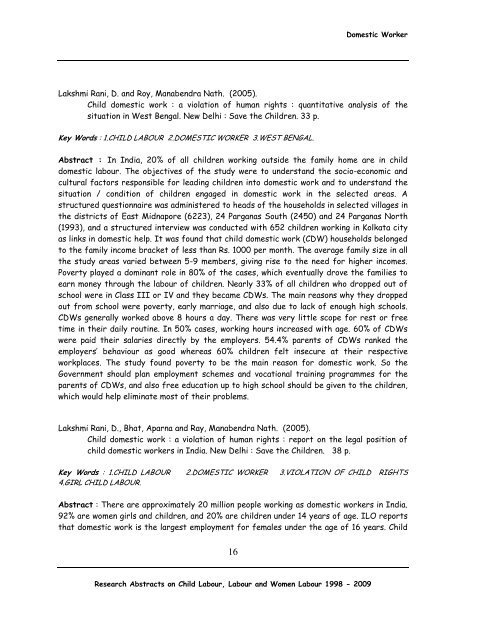Research Abstracts on Child Labour Women Labour - Nipccd
Research Abstracts on Child Labour Women Labour - Nipccd
Research Abstracts on Child Labour Women Labour - Nipccd
Create successful ePaper yourself
Turn your PDF publications into a flip-book with our unique Google optimized e-Paper software.
16<br />
<str<strong>on</strong>g>Research</str<strong>on</strong>g> <str<strong>on</strong>g>Abstracts</str<strong>on</strong>g> <strong>on</strong> <strong>Child</strong> <strong>Labour</strong>, <strong>Labour</strong> and <strong>Women</strong> <strong>Labour</strong> 1998 - 2009<br />
Domestic Worker<br />
Lakshmi Rani, D. and Roy, Manabendra Nath. (2005).<br />
<strong>Child</strong> domestic work : a violati<strong>on</strong> of human rights : quantitative analysis of the<br />
situati<strong>on</strong> in West Bengal. New Delhi : Save the <strong>Child</strong>ren. 33 p.<br />
Key Words : 1.CHILD LABOUR 2.DOMESTIC WORKER 3.WEST BENGAL.<br />
Abstract : In India, 20% of all children working outside the family home are in child<br />
domestic labour. The objectives of the study were to understand the socio-ec<strong>on</strong>omic and<br />
cultural factors resp<strong>on</strong>sible for leading children into domestic work and to understand the<br />
situati<strong>on</strong> / c<strong>on</strong>diti<strong>on</strong> of children engaged in domestic work in the selected areas. A<br />
structured questi<strong>on</strong>naire was administered to heads of the households in selected villages in<br />
the districts of East Midnapore (6223), 24 Parganas South (2450) and 24 Parganas North<br />
(1993), and a structured interview was c<strong>on</strong>ducted with 652 children working in Kolkata city<br />
as links in domestic help. It was found that child domestic work (CDW) households bel<strong>on</strong>ged<br />
to the family income bracket of less than Rs. 1000 per m<strong>on</strong>th. The average family size in all<br />
the study areas varied between 5-9 members, giving rise to the need for higher incomes.<br />
Poverty played a dominant role in 80% of the cases, which eventually drove the families to<br />
earn m<strong>on</strong>ey through the labour of children. Nearly 33% of all children who dropped out of<br />
school were in Class III or IV and they became CDWs. The main reas<strong>on</strong>s why they dropped<br />
out from school were poverty, early marriage, and also due to lack of enough high schools.<br />
CDWs generally worked above 8 hours a day. There was very little scope for rest or free<br />
time in their daily routine. In 50% cases, working hours increased with age. 60% of CDWs<br />
were paid their salaries directly by the employers. 54.4% parents of CDWs ranked the<br />
employers’ behaviour as good whereas 60% children felt insecure at their respective<br />
workplaces. The study found poverty to be the main reas<strong>on</strong> for domestic work. So the<br />
Government should plan employment schemes and vocati<strong>on</strong>al training programmes for the<br />
parents of CDWs, and also free educati<strong>on</strong> up to high school should be given to the children,<br />
which would help eliminate most of their problems.<br />
Lakshmi Rani, D., Bhat, Aparna and Ray, Manabendra Nath. (2005).<br />
<strong>Child</strong> domestic work : a violati<strong>on</strong> of human rights : report <strong>on</strong> the legal positi<strong>on</strong> of<br />
child domestic workers in India. New Delhi : Save the <strong>Child</strong>ren. 38 p.<br />
Key Words : 1.CHILD LABOUR 2.DOMESTIC WORKER 3.VIOLATION OF CHILD RIGHTS<br />
4.GIRL CHILD LABOUR.<br />
Abstract : There are approximately 20 milli<strong>on</strong> people working as domestic workers in India.<br />
92% are women girls and children, and 20% are children under 14 years of age. ILO reports<br />
that domestic work is the largest employment for females under the age of 16 years. <strong>Child</strong>

















